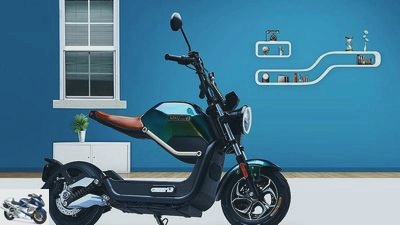Table of contents
- India increases subsidy for electric two-wheelers Emission-free two-wheelers from 2025
- Tuk Tuks will only be electric from 2023
- Subsidy for electric two-wheelers increased dramatically
- opinion poll
- Conclusion

Miku
counselor
traffic & business
India increases subsidy for electric two-wheelers
India increases subsidy for electric two-wheelers
Emission-free two-wheelers from 2025
The Indian government is planning to make two-wheelers with a displacement of less than 150 cc from 2025 emission-free, i.e. electric. Tuk Tuks have one more bike and should only be able to be registered as e-tuk tuk from 2023 onwards.
Uli Baumann,
Dina Dervisevic (co-author)
June 16, 2021
Around one sixth of global two-wheeler sales are concentrated on the Indian subcontinent. In the first quarter of 2019 alone, almost 22 million motorized two-wheelers were sold in India, most of which are scooters or small-volume motorcycles. In the same period, however, only 3.3 million new vehicles were brought into traffic in India. The two-wheelers make up over 3/4 of the Indian traffic. Because India is also increasingly suffering from pollution from traffic, the government wants to increasingly steer towards electromobility. Corresponding plans were already communicated in spring 2019
Tuk Tuks will only be electric from 2023
From April 2023, all three-wheeled vehicles – classics here are the extremely common auto rickshaws, better known as tuk tuks – will only be permitted with emission-free drives. From April 2025, these requirements will also apply to all two-wheelers with an engine – however, the plans include a displacement limit of 150 cm³. Large motorcycles were therefore spared the forced electrification. In parallel to the emission requirements, India wants to massively expand the infrastructure for electrically powered vehicles. Ola Electric plans to set up more than 100,000 charging stations under the name Hypercharger Network. TVS and Convergence Energy have also teamed up to create a similar network of charging stations across the country.
In 2018, around 126,000 electric two-wheelers were registered in India, compared to only about half in 2017. In February 2019, the Indian government launched a $ 1.4 billion funding program for electric and hybrid vehicles that is scheduled to run for three years.
Subsidy for electric two-wheelers increased dramatically
In June 2021, the FAME program (Faster Adoption and Manufacturing of Electric Vehicles in India) was revised and the subsidies for electric two-wheelers increased dramatically. The new directive provides for a whopping 50 percent increase in government subsidies to 15,000 rupees, which corresponds to around 170 euros per kWh. That will lead to massive price cuts on some of India’s most popular electric two-wheelers, such as the Bajaj Chetak and the TVS iQube. According to the FAME II guidelines, electric two-wheelers must meet certain parameters in order to be eligible for state funding, which in turn is limited to 40 percent of vehicle costs. For example, e-two-wheelers must have a proven range of at least 80 kilometers per charge and be able to travel at least 40 km / h.
In a report by the Indian automobile magazine AutoCar India, Tarun Mehta, CEO and co-founder of the electric scooter manufacturer Ather Energy, was enthusiastic about the revised FAME II guidelines. “Electric two-wheeler sales have grown despite the pandemic and with this additional subsidy we expect electric two-wheeler sales to turn the market upside down, reaching over 6 million units by 2025.”
opinion poll
How do you feel about the electric motorcycle??
Voted 8 times in 2018
Out of the question for me.
The future of the two-wheeler for urban traffic.
There is no getting around the electric motorcycle.
Conclusion
Where we are still skimpy in Germany and each municipality decides for itself whether and how it promotes electric mobility on two wheels, India shows how determined it is to advance the electrification of transport.
Related articles
-
Indonesia: From 2040 only electric two-wheelers
Yadea counselor traffic & business Indonesia: From 2040 only electric two-wheelers Electric timetable Indonesia From 2040 only electric two-wheelers When…
-
Ole Electric: $ 400 million for electric scooters
Ola Electric 9 pictures Ola Electric 1/9 In such a mega factory, Ola Electric plans to manufacture up to 10 million electric scooters a year in southern…
-
Electric Night Ride 2019 in Stuttgart: Exit for electric two-wheelers
© 2019 ENR • Powered by WPKoi Sports & scene Events Electric Night Ride 2019 in Stuttgart: Exit for electric two-wheelers Electric Night Ride 2019 in…
-
Wayel W3 electric scooter – e-scooter from Italy
Wayel 4th pictures Wayel 1/4 The Wayel W3 electric scooter is configured to suit the 125cc class. Wayel 2/4 It drives up to 75 km / h and should provide…
-
Driving bans for motorcycles: These cities lock out two-wheelers
Motorcycle noise Debate about the volume of motorcycles TuV Rheinland Group, Cologne counselor traffic & business Driving bans for motorcycles: These…
-
India – Germany on Enfield Taurus Diesel
to travel India – Germany on Enfield Taurus Diesel India – Germany on Enfield Taurus Diesel The long way home Driving from India to Germany by axis is…
-
Axiis Liion Electric Supermoto Concept 2019
Axiis counselor technology & future Axiis Liion Electric Supermoto Concept 2019 Axiis Liion (2019) Electric supermoto Motorcycle accessories manufacturer…
-
Niu N-GT, Niu M + electric scooter 2018
Niu 9 pictures Niu 1/9 The new Niu M + will be available in four color variants. Niu 2/9 It is the newest member of the M series from the Chinese…
-
Energica and Dell’Orto: partnership for electric drives
Energica Dellorto counselor technology & future Energica and Dell’Orto: partnership for electric drives Energica and Dell’Orto Partnership for electric…
-
Bosch patent for electric motor with ABS: brake charges battery
Bosch counselor technology & future Bosch patent for electric motor with ABS: brake charges battery Bosch patent for electric motor with ABS Brake…